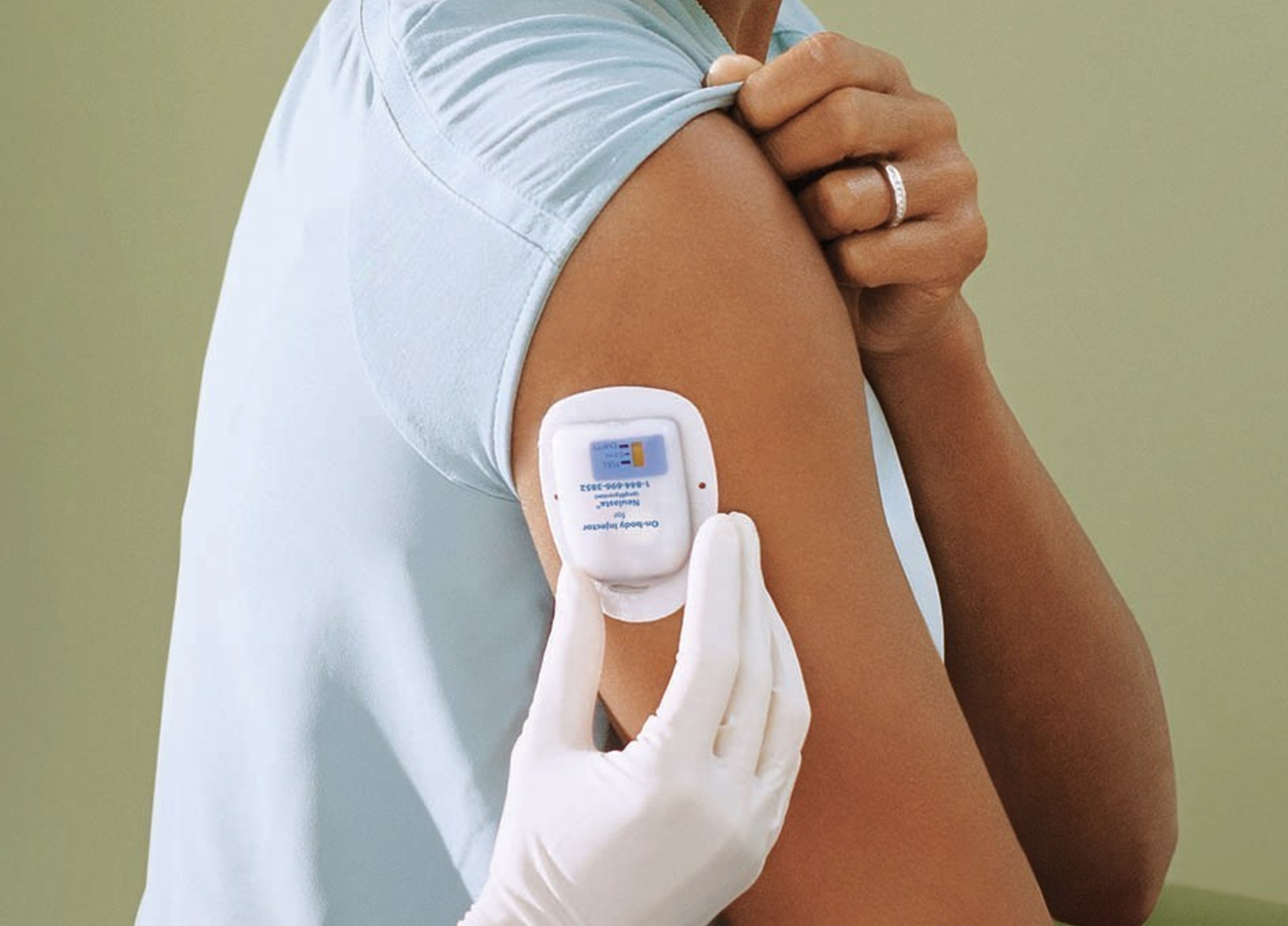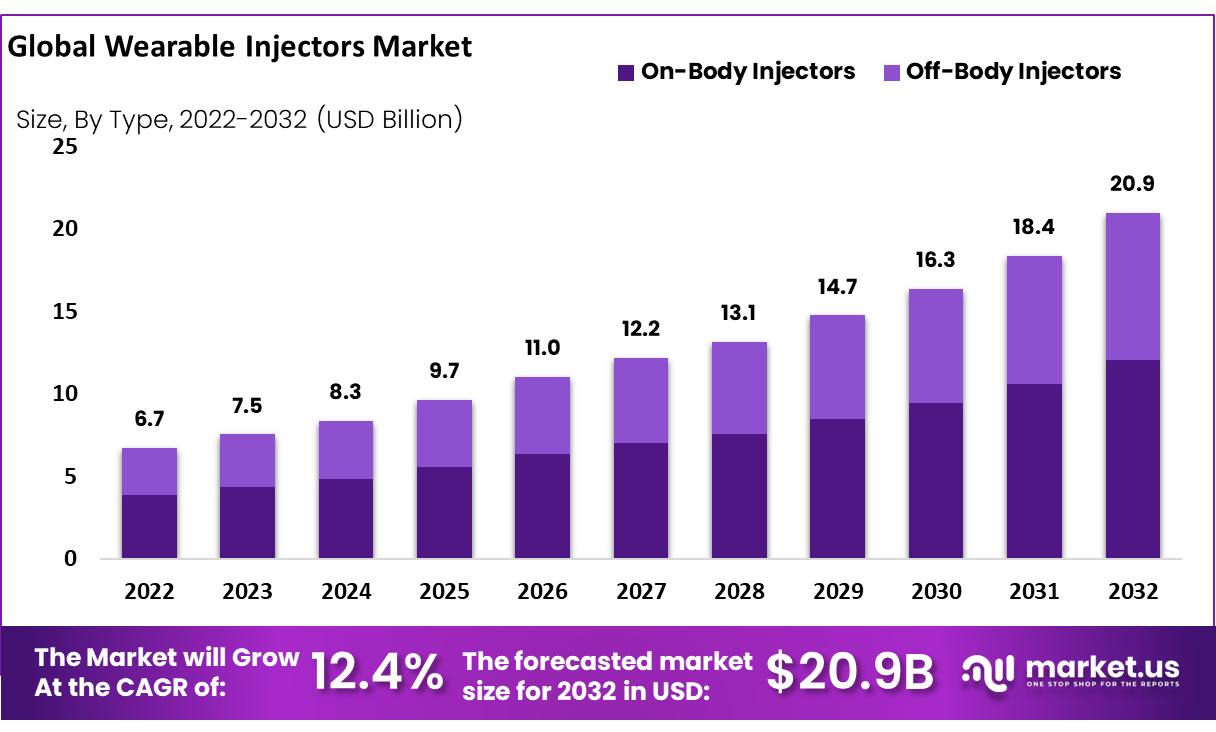Wearable Injectors Market To Grow Steadily With An Impressive CAGR Of 12.4% During The Forecast Period From 2022 To 2032: Market.us

Page Contents
Market Overview
Published Via 11Press : The wearable injectors market has experienced rapid expansion due to an increasing need for the self-administration of drugs. These devices were created specifically with patients in mind by providing self-medication without healthcare professionals' involvement.
The Global Wearable Injectors Market Size is anticipated to reach approximately USD 6.7 Billion by 2022 from USD 20.9 Billion in 2032; an expected compound annual compound growth rate of 12.4% during that forecast period.
There are three primary categories of wearable injectors on the market, such as on-body injectors, off-body injectors, and smart injectors. On-body injectors attach directly to the skin for extended subcutaneous delivery while off-body injectors include wearable pumps that can be attached to clothing or belts and delivered intravenously or subcutaneously via a catheter. Smart injectors come equipped with sensors that monitor drug delivery as well as record data such as dosage time of administration etc.
North America leads the wearable injector market due to its advanced healthcare infrastructure, rising prevalence of chronic diseases such as diabetes and cancer, high adoption rate of new technologies, and favorable reimbursement policies. Asia-Pacific however is anticipated to experience substantial growth during this forecast period owing to increasing investments into healthcare infrastructure as well as patient awareness regarding self-administration devices.
Key Takeaway
- Growing Demand: Wearable injector market has experienced steady expansion due to increasing interest from patients seeking patient-centric healthcare solutions and self-administration of injectable therapies.
- Wearable injectors offer several advantages over traditional methods, including increased patient comfort, medication adherence enhancements, precise dosing accuracy and greater mobility compared to their counterparts.
- Wearable injectors have various therapeutic applications, from diabetes management and oncology, cardiovascular conditions and autoimmune conditions, all the way up to treating allergies or dermatological disorders.
- Market Segmentation: The market can be divided up into segments based on product type (on-body injectors, off-body injectors and accessories), application, end user and geography.
Request For Sample Report Here: https://market.us/report/wearable-injectors-market/request-sample/
Regional Snapshot
- North America: North America has long been considered the primary market for wearable injectors. The region offers advanced healthcare infrastructure, an increasing prevalence of chronic illnesses, and strong technological innovation initiatives. Furthermore, major pharmaceutical and medical device companies help contribute to the North American market's expansion.
- Europe: Europe represents an enormous market for wearable injectors. With an established healthcare system and favorable reimbursement policies in place as well as rising adoption of advanced drug delivery technology solutions such as those used by Germany, the UK, and France – major contributors to market growth.
- Asia Pacific: Asia Pacific has seen explosive growth in its wearable injector market due to factors including population expansion, rising healthcare expenditure, the prevalence of chronic conditions such as diabetes and cancer, and increasing awareness about self-administration devices. China, Japan, India, and South Korea are key markets in the Asia Pacific for wearable injector sales.
- Latin America: Latin America is an emerging market for wearable injectors. As its population becomes more affected by chronic illnesses and more people seek innovative healthcare solutions, Brazil and Mexico are leading this growth of market growth within this region.
- Middle East and Africa: While the Middle East and Africa only hold a smaller market share for wearable injectors than other regions, its share is expected to increase as healthcare infrastructure and spending continue to improve as well as growing awareness for advanced drug delivery systems.
Drivers
- Increasing Prevalence of Chronic Diseases: The rising incidence of chronic diseases, such as diabetes, cancer, and cardiovascular disorders, is a major driver for the wearable injectors market. These conditions often require regular administration of medications, and wearable injectors provide a convenient and patient-friendly method for drug delivery.
- Growing Demand for Self-Administration: There is a growing trend towards self-administration of medications, as it offers patients greater control over their treatment and improves medication adherence. Wearable injectors enable patients to self-administer their medications in a safe and controlled manner, leading to improved treatment outcomes.
- Technological Advancements: Advances in wearable technology and drug delivery systems have led to the development of more advanced and user-friendly wearable injectors. These devices incorporate features such as precise dosing, programmable schedules, connectivity, and real-time monitoring, enhancing patient convenience and treatment effectiveness.
- Emphasis on Patient-Centric Healthcare: There is a shift towards patient-centric healthcare, focusing on improving patient experience and outcomes. Wearable injectors align with this approach by providing a more comfortable and less invasive drug delivery method, reducing the need for frequent clinic visits, and enabling patients to maintain their daily activities while receiving treatment.
Restraints
- High Cost: The cost of wearable injectors can be a significant barrier to market growth. These devices incorporate advanced technology and require precise engineering, which increases their manufacturing and development costs. This can limit their affordability and accessibility for some patients and healthcare systems.
- Regulatory Challenges: The wearable injectors market is subject to regulatory requirements and approvals, which can pose challenges and delays in product development and commercialization. Strict regulations related to safety, efficacy, and quality assurance must be met, which can increase the time and cost involved in bringing new devices to market.
- Limited Market Penetration in Developing Regions: While developed regions have witnessed significant adoption of wearable injectors, the market penetration in developing regions, particularly in low-income countries, is relatively limited. Factors such as limited healthcare infrastructure, lack of awareness, and affordability issues can restrain the market growth in these regions.
- Integration with Existing Healthcare Systems: The integration of wearable injectors into existing healthcare systems and workflows can pose challenges. Ensuring interoperability with electronic health records, training healthcare professionals on device usage, and addressing concerns related to data security and privacy are some of the factors that need to be addressed for seamless adoption of wearable injectors.
Opportunities
- Expansion in Therapeutic Applications: The wearable injectors market presents opportunities for expansion into new therapeutic areas. Currently, the market is primarily focused on applications such as diabetes, oncology, and cardiovascular diseases. However, there is potential for wearable injectors to be utilized in other areas, including autoimmune disorders, hormonal therapies, pain management, and neurodegenerative diseases.
- Increasing Adoption of Biologics: The growing use of biologic drugs, including monoclonal antibodies and protein-based therapies, provides an opportunity for wearable injectors. These medications often require subcutaneous administration and can benefit from the precise dosing and convenience offered by wearable injectors.
- Remote Patient Monitoring and Telemedicine: The rise of remote patient monitoring and telemedicine presents opportunities for wearable injectors. These devices can be integrated with digital health platforms to enable remote monitoring of patient's medication adherence, treatment progress, and vital signs. Wearable injectors equipped with connectivity features can transmit data to healthcare providers in real time, facilitating remote consultations and personalized care.
- Personalized Medicine and Therapeutic Regimens: Wearable injectors have the potential to support personalized medicine and individualized treatment regimens. These devices can be programmed to deliver precise doses at specific times, allowing for tailored treatment plans based on patient's specific needs and responses. This can lead to improved treatment outcomes and patient satisfaction.
Make an inquiry before picking up this report @ https://market.us/report/wearable-injectors-market/#inquiry
Challenges
- Safety and Reliability Concerns: Ensuring the safety and reliability of wearable injectors is a significant challenge. These devices must be designed to prevent dosing errors, leakage, or mechanical failures that could compromise patient safety. Rigorous testing, quality control, and adherence to regulatory standards are essential to address these concerns.
- User Acceptance and Training: The successful adoption of wearable injectors relies on user acceptance and proper training. Patients and healthcare providers need to be educated about the benefits, usage, and maintenance of these devices. Overcoming resistance to change and addressing concerns related to devising complexity or fear of self-administration may pose challenges.
- Reimbursement and Affordability: Reimbursement policies and pricing can impact the adoption of wearable injectors. Demonstrating the cost-effectiveness and clinical benefits of these devices is crucial for obtaining favorable reimbursement and making them affordable for patients and healthcare systems.
- Integration with Healthcare Systems: Integrating wearable injectors into existing healthcare systems and workflows can be challenging. Ensuring interoperability with electronic health records, training healthcare professionals on device usage, and streamlining the data exchange processes require coordination and collaboration among various stakeholders.
Key Market Players
- Becton, Dickinson, and Company
- Ypsomed
- Amgen
- Insulet Corporation
- Tandem Diabetes Care, Inc.
- Johnson & Johnson Private Limited
- Hoffmann-La Roche AG
- Unilife Corporation
- West Pharmaceuticals Services, Inc.
- Medtronic
- SteadyMed Ltd.
- Other Key Players
Key Market Segments
Based on Type
- On-Body Injectors
- Off-Body Injectors
Based on Applications
- Oncology
- Diabetes
- Autoimmune Disease
- Cardiovascular Disease
- Other Applications
Based on Technology
- Spring-based
- Motor-driven
- Rotary Pump
- Expanding Battery
- Other Technologies
Based on End-User
- Hospitals & Clinics
- Home Care
- Other End-Users
Top Impacting Factors
- Increasing Prevalence of Chronic Diseases: The rising prevalence of chronic diseases, such as diabetes, cancer, and cardiovascular disorders, is a significant factor driving the demand for wearable injectors. These conditions often require regular administration of medications, and wearable injectors provide a convenient and patient-friendly method for drug delivery.
- Technological Advancements: Continuous advancements in wearable technology and drug delivery systems have a significant impact on the wearable injectors market. Innovations in device design, connectivity features, dosing accuracy, and real-time monitoring capabilities contribute to the adoption of wearable injectors by improving patient convenience, treatment effectiveness, and data collection for healthcare providers.
- Patient-Centric Approach and Self-Administration: There is a growing emphasis on patient-centric healthcare, which includes empowering patients to actively participate in their treatment. Wearable injectors enable self-administration of medications, giving patients greater control over their therapy, enhancing medication adherence, and improving patient satisfaction.
- Adoption of Biologic Drugs: Biologic drugs, including monoclonal antibodies and protein-based therapies, are being increasingly utilized in various therapeutic areas. These medications often require subcutaneous administration, which aligns with the capabilities of wearable injectors. The rising adoption of biologics fuels the demand for wearable injectors as a preferred drug delivery method.
- Remote Patient Monitoring and Telemedicine: The integration of wearable injectors with remote patient monitoring and telemedicine technologies opens up new possibilities in healthcare delivery. By allowing real-time monitoring of medication adherence, treatment response, and patient health parameters, wearable injectors facilitate remote consultations, personalized care, and the optimization of treatment regimens.
Recent Developments
- AbbVie was granted approval from the US FDA on June 20, 2022, to market SKYRIZI RISANKIZAB RAZAA as the only and first interleukin 23 inhibitors (IL-23) designed specifically to treat adults suffering from severe or moderate chronic Crohn's Disease. It can be administered both subcutaneously (SC), as well as through On-Body Injector(OBI).
- Enable Injections successfully raised USD 215 Million to finance the development of their subcutaneous delivery device Enthuse for drugs. Enthuse is comprised of both an implantable delivery disk as well as the concept to move drugs out of their initial container.
Report Scope
| Report Attribute | Details |
| The market size value in 2022 | USD 6.7 Bn |
| Revenue Forecast by 2032 | USD 20.9 Bn |
| Growth Rate | CAGR Of 12.4% |
| Regions Covered | North America, Europe, Asia Pacific, Latin America, and Middle East & Africa, and Rest of the World |
| Historical Years | 2017-2022 |
| Base Year | 2022 |
| Estimated Year | 2023 |
| Short-Term Projection Year | 2028 |
| Long-Term Projected Year | 2032 |
Frequently Asked Questions
Q: What is the current size of the Wearable Injectors Market?
A: The Global Wearable Injectors Market size is USD 6.7 Billion in 2022.
Q: What is the projected growth rate for Wearable Injectors Market?
A: The Wearable Injectors Market is expected to grow at a CAGR of 12.4% from 2023 to 2032.
Q: What are some of the key players in the Wearable Injectors Market?
A: Some of the key players in the Wearable Injectors market include QIAGEN N.V., OPKO Health, Siemens Medical Solutions USA, Inc., Quest Diagnostics, Abbott Laboratories, NeoGenomics Laboratories, Inc, Fresenius Medical Care AG & Co., Sonic Healthcare Limited, Associated Regional and University Pathologists, Inc., Laboratory Corporation of America Holdings, Other Key Players
Contact:
Global Business Development Team – Market.us
Market.us (Powered by Prudour Pvt. Ltd.)
Send Email: [email protected]
Address: 420 Lexington Avenue, Suite 300 New York City, NY 10170, United States
Tel: +1 718 618 4351
Website: https://market.us
Content has been published via 11press. for more details please contact at [email protected]
The team behind market.us, marketresearch.biz, market.biz and more. Our purpose is to keep our customers ahead of the game with regard to the markets. They may fluctuate up or down, but we will help you to stay ahead of the curve in these market fluctuations. Our consistent growth and ability to deliver in-depth analyses and market insight has engaged genuine market players. They have faith in us to offer the data and information they require to make balanced and decisive marketing decisions.




